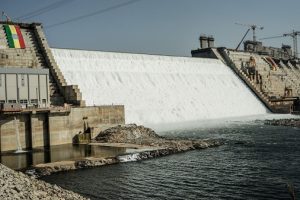BY JOCELYN TIMPERLEY
Tackling climate change could require sucking carbon back out of the atmosphere, according to the IPCC. Jocelyn Timperley looks at how these ‘negative emissions’ might work.
Humanity is on thin ice. Only rapid reductions in fossil fuel use, increased efficiency and deep reductions in greenhouse gas emissions in all sectors can mean we avoid the worst of climate change, according to a new report published by the United Nation’s (UN) Intergovernmental Panel on Climate Change (IPCC).
The new report should serve as an “a survival guide for humanity”, according to UN chief Antonio Guterres, who recommended an “everything, everywhere, all at once” approach to climate action. Alongside measures to reduce the amount of carbon being emitted into the atmosphere, this approach will likely need include another action that scientists see as increasingly, if frustratingly, necessary: carbon dioxide (CO2) removal.
The term refers to a variety of mechanisms and technologies that would pull CO2 back out of the air and trap it so it cannot contribute to the greenhouse effect that is warming our planet. The idea is to actively reverse the emissions that humans have pumped into the atmosphere. Techniques on the table include everything from direct air capture or bioenergy with carbon capture and storage (CCS) to bio char or enhanced rock weathering.
But how feasible is it to scale the assorted proposed methods for removing CO2 to the levels that would make a meaningful difference to the climate? Are some options better than the others? And which schemes run the risk of simply being too crackpot to ever stand a chance?
Since the world has now failed for decades to curb the rise of greenhouse gas emissions, some form of CO2 removal is now seen by many scientists as essential to limiting dangerous climate change. (Read more about how the climate is faring in 2023).
Rob Bellamy, a lecturer in climate and society at the University of Manchester, says the IPCC report makes it clear that taking CO2 out of the air is “not just an option – but a necessity”. However he warned carbon removal methods also bring significant risks to both people and the environment.
“We now need a wide-ranging societal conversation about which methods to take forward, how to incentivise them, and ultimately how to govern them. Make no mistake, we need to do carbon removal; but we need to do it responsibly.”
In particular, the new IPCC report notes that CO2 removal will be needed to counterbalance “hard-to-abate residual greenhouse gas emissions” in order to reach net-zero CO2 or greenhouse gas emissions. Sectors with these hard-to-abate emissions include agriculture, aviation, shipping and industrial processes, it notes (these sectors are consider hard to reduce emissions in either due to a lack of technology or the high expense of decarbonisation).
But not all scientists agree. Some are concerned about the feasibility of CO2 removal on a large scale and say it would be a mistake to rely too heavily upon it. They also warn it could provide an unwarranted and risky excuse for governments to avoid the deep emissions cuts needed to tackle climate change.
“The IPCC reports show that we can prevent irreversible harm to people and the planet if we scale up proven solutions available now: replacing fossil fuels with renewables, increasing energy efficiency, and reducing energy and resource use are the surest path to limiting global warming to 1.5C,” says Lili Fuhr, deputy director of the climate and energy programme, at the Center for International Environmental Law (CIEL), a non-profit environmental law firm based in Geneva, Switzerland.
“Building our mitigation strategies on models that instead lock in inequitable growth and conveniently assume away the risks of techno fixes like carbon capture and storage and CO2 removal ignores that clarion message and increases the likelihood of overshoot,” says Fuhr. (See below for more on climate overshoot)
How much do we need?
Earlier this year, a report led by researchers at the University of Oxford gave the first ever full assessment of the current state of CO2 removal by humans globally. It calculated this number at around two billion tonnes (GT) of CO2 per year, the vast majority from land. This is equal to roughly 5% of the 36.6 GtCO2 emitted into the atmosphere by the use of fossil fuels and cement in 2022.
But there are currently few plans by countries to scale up CO2 removal above current levels, the report found. In its own assessments, the IPCC looks at different pathways to achieving emissions cuts in line with various degrees of ambition. Most of these pathways now require some level of CO2 removal techniques, and virtually all scenarios consistent with the Paris Agreement goals to limit warming to 1.5C or well below 2C include at least some CO2 removal. The world is currently on track for 2.4C rise by 2100 if all UN country climate pledges are fully implemented, or 2.8C by 2100 if only the climate policies already in place are considered.
The exact amount of removal needed to reach this level, however, strongly depends on what cuts to emissions are made – making it hard to put an exact figure on it. Scenarios showing steep and rapid emissions cuts require the lowest amount of CO2 removal.
Some of the IPCC scenarios also allow for “climate overshoot” – a period when the global temperature goals are temporarily exceeded before dropping back to the targeted value. Bringing temperatures down like this would require some kind of CO2 removal, the IPCC says.
What are the options?
There are a huge variety of different ways we could potentially remove CO2 from the air. It’s worth noting, however, that no technological methods have been proven at scale. The graph below shows the estimated emissions reduction potential of several different techniques from the University of Oxford CO2 removal assessment.
Bioenergy with carbon capture and storage (CCS) is the most prominent technological method in the IPCC report. Here, trees are grown to capture CO2 before being burnt in a plant for energy. The emissions from the plant are captured and stored permanently underground, a practice known as CCS.
Another much discussed technological method for removing CO2 from the atmosphere is direct air capture (DAC). The technique uses machines to pull CO2 directly out of the air. If this CO2 is permanently stored underground using CCS, the overall emissions are negative. The vast majority of investment between 2020 and 2022 focused on this form of CO2 removal. (Read more about the device that reverses CO2 emissions.)
Using biochar for CO2 removal, meanwhile, would involve using biomass such as trees or plant matter, which has captured carbon while growing, being pyrolysed (heated in the absence of oxygen) to produce a black, coal-like substance which consists mainly of elemental carbon. This biochar can then be added to soils, in theory locking the carbon away.
Enhanced rock weathering has also been proposed as a way to remove CO2 from the atmosphere. This would consist of spreading large amounts of finely ground silicate rock such as basalt onto land in an effort to mimic natural rock weathering, eventually leading to CO2 being trapped in the ocean as bicarbonate or locked up on the sea floor.
Finally, ocean alkalinisation is another proposed process which would involve adding alkaline materials to the ocean such as silicate or carbonate rocks to increase the amount of CO2 it takes in. Similarly, ocean fertilisation would involve stimulating phytoplankton growth in the ocean to enhance carbon sequestration.
Despite being much hyped, these “novel” methods of CO2 are also in reality still in their infancy. Steve Smith, executive director of Oxford Net Zero and CO2RE at the University of Oxford and lead author of the CO2 removal assessment, notes that even combined all of the above methods remove just two million tonnes of CO2 per year (Mt CO2/yr). That is an amount equal to 0.005% of global fossil fuel and cement emissions in 2022.
According to the CO2 removal assessment, capture via these methods need to grow by four to six orders of magnitude by mid-century to meet the Paris Agreement temperature goals.
Could concrete be a climate saviour?
But there are other ways to capture and store carbon which are already in far wider use, the assessment noted. In fact, 99.9% of the 2Gt of anthropogenic CO2 removal which takes place each year occurs via ways we manage land – in particular forest management, afforestation and reforestation. Restoration of other ecosystems which store a lot of carbon, such as peat lands and mangroves are also important sources.
Restoring these ecosystems also provides huge co-benefits as it is essential to increasing resilience to climate change impacts and tackling the biodiversity crisis.
The limits of negative emissions
Still, there are limits to how much these natural systems can capture carbon. Scientists have warned we must not place too much faith in trees to save us, and that they certainly cannot reverse climate change on their own. There are also risks that restoration of these ecosystems might not prove permanent, especially as temperatures rise, so the CO2 they have stored could end up being released back into the atmosphere.
And scientists warn there could be significant issues with scaling up many of the novel technologies too. For example, many experts consider ocean alkalisation and fertilisation too risky for the marine environment and think they may not work anyway.
A large-scale rollout of bioenergy with CCS, meanwhile, would require enormous areas of land to be turned over to bioenergy crops, which could in turn imperil food systems and conservation of ecosystems. There are similar concerns for the large amount of land that would be needed for biochar production (the long-term impacts of wide-scale biochar use are also unknown), and the high temperatures needed to produce biochar require lots of energy.
Similarly, pulverising rock for enhanced rock weathering would also use lots of energy and could be very expensive. DAC with CCS is also energy-intensive and could prove extremely expensive to deploy at large scales, although some scientists are working on new methods they hope could be cheaper.
There are increasing numbers of CCS facilities around the world, but carbon storage has not yet been achieved on a large scale and, the IPCC notes, is currently far below what is needed. However, the IPCC says that there is enough technical geological storage capacity globally for all CO2 storage needed through 2100 to limit global warming to 1.5C.
Although scientists are settling on the need for negative emissions at some point in the future, the lion’s share of the emissions gap to 2030 still ought to be closed by cutting emissions, says Smith. In the absence of new policies to tackle climate change, however, we only get roughly to a flat lining of global emissions during 2020-2030. CO2 removal then becomes crucial, he says – especially over the longer-run.
Responding to the new IPCC report, climate activist Greta Thunberg called the failure of those in power to act on the climate crisis an “unprecedented betrayal”. Sadly, the world may now be entering the territory of having to undo the damage using methods that are far more difficult and risky than it would have been to stop emissions in the first place.
(Source:BBC)
The Ethiopian Herald March 23/2023




